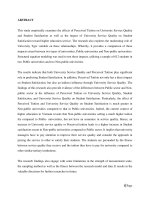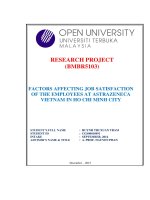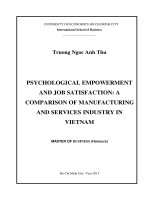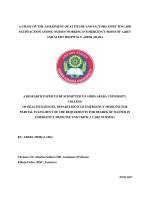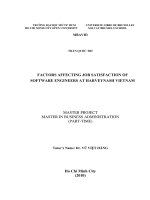Factors affecting job satisfaction a comparison between state owned and non state owned enterprises in vietnam
Bạn đang xem bản rút gọn của tài liệu. Xem và tải ngay bản đầy đủ của tài liệu tại đây (672.65 KB, 66 trang )
1
UNIVERSITY OF ECONOMICS HO CHI MINH CITY
International School of Business
------------------------------
LE ANH TAI
Factors affecting job satisfaction: A comparison
between state-owned and non state-owned
enterprises in Viet Nam
MASTER OF BUSINESS (HONOURS)
Ho Chi Minh – Year 2012
2
UNIVERSITY OF ECONOMICS HO CHI MINH CITY
International School of Business
------------------------------
LE ANH TAI
Factors affecting job satisfaction: A comparison
between state-owned and non state-owned
enterprises in Viet Nam
ID: 60340102
MASTER OF BUSINESS (HONOURS)
SUPERVISOR: Dr. NGUYEN HUU LAM
Ho Chi Minh City – Year 2012
i
ABTRACT
The turn-over rate of Vietnamese companies has been so high recently, which
causes many troubles for Vietnamese enterprises, such as recruitment and training.
However, the most factor causes high turn-over rate of Vietnamese companies is job
dissatisfaction. Therefore, this research is conducted to find out the most factors
affecting job satisfaction in order to make a contribution into reducing turn-over
rate of Vietnamese companies. This research investigates employees working in
state-owned and non-state-owned companies in Ho Chi Minh City. The results
demonstrate career prospect has the most contribution in job satisfaction and
employees who are working in non-state-owned companies are more satisfied than
ones in state-owned companies.
ii
ACKNOWLEDGEMENTS
I would like to express my obligation to my Supervisor, Dr. Nguyen Huu Lam, for
his supporting and inspiration. Furthermore, I would like to show my thankful to
Dr. Nguyen Dinh Tho for his clear instruction during our study, which has a lot of
useful methods and practical implications for our study and career. Besides, I would
like to thank to my friends in MBUS 2010 who had supported me a lot during my
thesis implementation. And an honorable mention goes to my family, my friends
and my colleagues for understanding and helping me during my data collection as
well as my thesis completion.
Ho Chi Minh City, Vietnam
January 2nd, 2013
iii
TABLE OF CONTENTS
ABTRACT .................................................................................................................. i
ACKNOWLEDGEMENTS ....................................................................................... ii
CHAPTER 1. INTRODUCTION ...............................................................................1
1. Background .......................................................................................................1
2. Problem statement.............................................................................................2
3. Research objective ............................................................................................2
4. Research scope ..................................................................................................3
5. Practical implication .........................................................................................3
6. Research structure .............................................................................................3
CHAPTER 2. LITERATURE REVIEW ....................................................................4
1. Introduction .......................................................................................................4
2. Job satisfaction ..................................................................................................4
3. Maslow's hierarchy of needs.............................................................................4
4. Herzberg's Motivation-Hygiene Theory ...........................................................5
5. McGregor's Theory X and Theory Y ................................................................7
6. Incentive............................................................................................................8
7. Employee satisfaction measurement.................................................................8
8. Hypotheses ......................................................................................................15
9. Conceptual model ...........................................................................................15
CHAPTER 3. RESEARCH METHODOLOGY ......................................................17
1. Introduction .....................................................................................................17
2. Research design...............................................................................................17
2.1.
Research methods.....................................................................................17
2.2.
Research process ......................................................................................18
3. Variable Coding ..............................................................................................19
4. Data collection ................................................................................................22
CHAPTER 4. RESEARCH RESULT ......................................................................23
1. Introduction .....................................................................................................23
iv
2. Statistics ..........................................................................................................23
2.1.
Observation description ...........................................................................23
2.2.
Variable description .................................................................................24
3. Scale analysis ..................................................................................................25
3.1.
Reliability analysis (Cronbach alpha) ......................................................25
3.2.
Validity analysis (factor analysis) ............................................................29
3.3.
Adjusted Conceptual model .....................................................................33
4. Analysis...........................................................................................................34
4.1.
Correlation analysis..................................................................................34
4.2.
Regression analysis ..................................................................................35
5. Discussions......................................................................................................39
5.1.
Hypothesis testing ....................................................................................39
5.2.
Analysis result discussions.......................................................................41
CHAPTER 5. CONCLUSION..................................................................................43
1. Introduction .....................................................................................................43
2. Conclusions on the research problem and hypotheses....................................43
3. Implications for human resource manager......................................................43
4. Research contributions ....................................................................................44
5. Limitations ......................................................................................................44
REFERENCES..........................................................................................................45
BIBLIOGRAPHY .....................................................................................................47
APPENDIX ...............................................................................................................48
Appendix 1: Vietnamese questionnaire .................................................................48
Appendix 2: English questionnaire........................................................................52
Appendix 3: Regression standardized residual and homoscedasticity ..................56
v
LIST OF TABLES
Table 1: factors affecting job attitudes........................................................................6
Table 2. Job satisfaction measurement (OSI) ...........................................................11
Table 3. Job satisfaction instrument..........................................................................14
Table 4. Variable coding ...........................................................................................21
Table 5: Demographic description ............................................................................24
Table 6: Variable description ....................................................................................25
Table 7. Cronbach Alpha ..........................................................................................27
Table 8. Cronbach Alpha adjustion...........................................................................29
Table 9: factor analysis .............................................................................................31
Table 10. Data reduction ...........................................................................................32
Table 11: Correlation analysis ..................................................................................34
Table 12. Multi linear regression analysis (1)...........................................................35
Table 13. Multi linear regression analysis (2)...........................................................35
Table 14. Multi linear regression analysis (3)...........................................................36
Table 15. Multi linear regression analysis between state-owned and non-stateowned companies (1) ................................................................................................37
Table 16. Multi linear regression analysis between state-owned and non-stateowned companies (2) ................................................................................................37
Table 17. Multi linear regression analysis between state-owned and non-stateowned companies (3) ................................................................................................38
vi
LIST OF FIGURES
Figure 1. Maslow hierarchy of needs..........................................................................5
Figure 2. OSI model ....................................................................................................9
Figure 3. Conceptual model ......................................................................................16
Figure 4. Process of analysis.....................................................................................18
Figure 5. Adjusted conceptual model .......................................................................33
vii
LIST OF ABBREVIATIONS
JS: Job satisfaction
WCA: Working conditions and activities
WC: Working conditions
WA: Work activities
S: Salary
R: Relationship
CP: Career prospects
1
CHAPTER 1. INTRODUCTION
1. Background
Vietnam started a profound economic reform in 1986 that aimed to transform the
country from a command economy into a market oriented economy. From the early
days of the economic reform, economic structural reforms and open-door policies
have become an integral part of overall economics (World Bank, 1999). As a
consequence, Vietnam substantially elevated its economy and the living standards
of Vietnamese people. The country reaped average economic growth rate (GDP) of
over 7% during the 1990s and early 2000s, especially more than 8% in 2006, which
made it one of the highest growing economies in the World (World Bank, 2006).
In the booming economic period and the globalization, many foreign enterprises
join into the Vietnamese economy as a Joint Venture Company. They applied many
modern management methods and incentive policies, which are spread to many
state owned and private Vietnamese companies. Opening up the market brought
both threats and opportunities. Some businesses thrived in the new business
environment and were able to improve productivity, product quality, and ultimately
profit. Others failed to meet the new challenges and declined. Under competitive
pressure, Vietnamese companies, including state owned companies, private
companies and joint venture companies try to maximize their performance such as
financial performance, production performance, sales performance, etc. Besides,
employees also take an important essential role in development. Base on Maslow
(1954) the personal needs go along with their development. So, employees need
more and more from their works, their devotion for company development.
However, their requirements have not always met; they usually suffer from their job
and find new changes in their life. Another remarkable is the distribution of
Vietnamese labor forces. They mostly focus on the big cities, such as Ha Noi and
Ho Chi Minh City or so. The movement of labor forces is clearly depicted in the
Vietnamese industrial zones where concentrate a large number of unskilled labors.
2
They usually move their jobs, which heavily damages enterprise’s human resources.
A large amount of money is spent for new recruitment and training, which seem to
be the common issue of many Vietnamese enterprises today. The Vietnamese labor
force newspaper (2010) states that 15-20 percentages of employees in Vietnamese
industrial zones change their jobs. Maintaining the labor forces is an emerging
problem of Vietnamese enterprises.
2. Problem statement
According Towers Watson (2011), the Vietnamese average turnover rate of 2011 is
17,8%. The number shows that Vietnamese companies have been faced with high
turnover rate, which will damage to the company image and development.
According to an analysis of IMQ Consulting experts, the main reason of employee
turnover is not the employee's salary problem. In most cases of leave of employees,
the main causes are the conflicts and disagreements between staffs and manager
operating behaviors, which will lead job dissatisfaction. In some cases, it may be
the working environment less stable and corporate culture has not been focused.
Briefly, job dissatisfaction is the most factor leading high employee turnover rate in
Vietnam.
3. Research objective
Job dissatisfaction has become the common problem for many companies in
Vietnam. Not only it causes employees’ depression, but also it harms the
enterprises’ performance, especially in human resource. The problem statement
states that job dissatisfaction is the most factor of high turnover rate in Vietnamese
companies. Therefore, this research is conducted to understand the job satisfaction
in Vietnamese companies deeply. The goals of this research are striving to find out
the key factors effect on employee job satisfaction in Vietnamese companies,
making a comparison in employee job satisfaction between state owned and nonstate owned sectors, finding the most influential factors on employee satisfaction in
3
each sector, recommending the improvements of the existing incentive system to
increase job satisfaction in Vietnamese companies.
4. Research scope
Due to the limitation of duration, this research can only focus on the South
Vietnamese company including state owned, and non-state owned enterprises. The
subjects of this research are employees, low level managers and middle level
managers.
5. Practical implication
Despite there are a lot of researches in job satisfaction, this research is also
conducted to determine the most factor affecting on job satisfaction. This result can
make a little bit contribution to reduce the high turnover rate in Vietnamese
companies and help human resource managers in planning strategies to maintain
their labor forces.
6. Research structure
This research will be composed of 5 Chapters:
Chapter 1: Introduction. It introduces research background, research problem,
research objective, research question as well as benefit of the research.
Chapter 2: Literature review. This chapter reviews theories and selects the
research’s factors as well as formulates the research hypotheses and model.
Chapter 3: Research methodology. This chapter provides general idea how the
research will be designed and implemented.
Chapter 4: Research result. This chapter translates data collected from survey,
analyses data as well as discusses the result finding in connection with theory.
Chapter 5: Conclusion. This Chapter concludes the research finding; provide further
suggestion as well as research limitation.
4
CHAPTER 2. LITERATURE REVIEW
1. Introduction
This chapter reviews the theories in job satisfaction and claims the scale for
measuring them. It includes the definition of job satisfaction, theories of job
satisfaction such as Maslow hierarchy of needs, Herzberg’s motivation – hygiene
theory, McGregor’s theory X and theory Y, and reviewing the popular job
satisfaction scales in recent.
2. Job satisfaction
Base on C. L. Hulin (1966), job satisfaction is an effective response of the worker to
his job. It is viewed as a result or consequence of the worker’s experience on the job
in relation to his own values, that is to what he wants or expects from it, satisfaction
can be viewed as similar in meaning to pleasure.
Brayfield and Rothe (1951) recommend the 7 point scale to measure job
satisfaction, which includes five observation factors, satisfied with present job, job
enthusiastically, enjoying working time, job enjoyment, job vice versus unpleasant
things. They can be stated by five statements:
-
I feel fairly satisfied with my present job.
-
Most days I am enthusiastic about my work.
-
Each day of work seems like it will never end.
-
I find real enjoyment in my work.
-
I consider my job rather unpleasant.
3. Maslow's hierarchy of needs
Base on Maslow (1954) the most working expectation of employees are having a
job and a stable income to support themselves and their family, feeling safety and
stable for a long time while working, feeling taking a part in company development,
well assessed and believable from supervisors and subordinates, improving
5
knowledge and recognition, self-promoting and building up a long term career. We
can see the expectation tendency in Figure 1 below.
Figure 1. Maslow hierarchy of needs
However, there are many reasons which are threatening employees’ expectation and
make them dissatisfied with their job. These troubles mostly come from the
behavior of management and the company structure. These are weaknesses in
ability to receive and process issues, not giving clear personnel policies, not keeping
the commitment with staffs, wanton task delegating and not based on ethical rule,
employee emotional assessing, maintaining family management style, etc. These
poor working conditions cause employee dissatisfaction.
4. Herzberg's Motivation-Hygiene Theory
Herzberg (1966) developed the motivation-hygiene theory to explain employee
satisfaction. The following table 1 presents the top six factors causing
dissatisfaction and the top six factors causing satisfaction, listed in the order of
highest to lowest importance.
6
Leading to Dissatisfaction
Leading to Satisfaction
∑
Company policy
∑
Achievement
∑
Supervision
∑
Recognition
∑
Relationship w/Boss
∑
Work itself
∑
Work conditions
∑
Responsibility
∑
Salary
∑
Advancement
∑
Relationship w/Peers
∑
Growth
Table 1: factors affecting job attitudes
Herzberg reasoned that because the factors causing satisfaction are different from
those causing dissatisfaction, the two feelings cannot simply be treated as opposites
of one another. The opposite of satisfaction is not dissatisfaction, but rather, no
satisfaction. Similarly, the opposite of dissatisfaction is no dissatisfaction.
From the above table of results, one observes that the factors that determine whether
there is dissatisfaction or no dissatisfaction are not part of the work itself, but rather,
are external factors. Herzberg often referred to these hygiene factors as "KITA"
factors, where KITA is an acronym for a kick in the ass, the process of providing
incentives or a threat of punishment to cause someone doing something. Herzberg
argues that these provide only a short-run success because the motivator factors that
determine whether there is a satisfaction or no satisfaction are intrinsic to the job
itself, and do not result from carrot and stick incentives.
Herzberg argued that job enrichment is required for intrinsic motivation, and that it
is a continuous management process. According to Herzberg:
∑
The job should have sufficient challenge to utilize the full ability of the
employee.
∑
Employees who demonstrate increasing levels of ability should be given
increasing levels of responsibility.
7
∑
If a job cannot be designed to use an employee's full abilities, then the firm
should consider automating the task of replacing the employee with one who
has a lower level of skill. If a person cannot be fully utilized, then there will
be a motivation problem.
Critics of Herzberg's theory argue that the two-factor result is observed because it is
natural for people to take credit for satisfaction and to blame dissatisfaction on
external factors. Furthermore, job satisfaction does not necessarily imply a high
level of motivation or productivity.
5. McGregor's Theory X and Theory Y
Douglas McGregor (1957) developed a philosophical view of humankind with his
Theory X and Theory Y — two opposing perceptions about how people view
human behavior at work and organizational life. McGregor felt that organizations
and the managers within them followed either one or the other approach:
Theory X
∑
People have an inherent dislike for work and will avoid it whenever possible.
∑
People must be coerced, controlled, directed, or threatened with punishment
in order to get them to achieve the organizational objectives.
∑
People prefer to be directed, do not want responsibility, and have little or no
ambition.
∑
People seek security above all else.
In an organization with Theory X assumptions, management's role is to coerce and
control employees.
Theory Y
∑
Work is as natural as play and rest.
8
∑
People will exercise self-direction if they are committed to the objectives
(they are NOT lazy).
∑
Commitment to objectives is a function of the rewards associated with their
achievement.
∑
People learn to accept and seek responsibility.
∑
Creativity, ingenuity, and imagination are widely distributed among the
population. People are capable of using these abilities to solve an
organizational problem.
∑
People have potential.
6. Incentive
Pouliakas, Konstantinos (2008) proves that there is a significant impact between
monetary incentives and job satisfaction. Indeed, the significant negative
association between small bonus payments and the satisfaction of workers with the
actual job itself constitutes evidence in low paid salary assumption.
He also
emphasize that the introduction of a monetary incentive is likely to alter the nature
of an incomplete contract. For instance, if workers had previously engaged in
certain job tasks without compensation, once the employer associates those
activities with the payment of bonuses the perception of the contract now changes,
with the employee expecting to be paid for the execution of those tasks in the
future. It is found that the average job satisfaction of those workers switching from
no bonus payments to incentive policy is greater than others.
7. Employee satisfaction measurement
OSI (Occupational Stress Indicator) is based on the Cooper and Marshal stress
model (1976). It has an appropriate tool to help us diagnose the critical aspects of
organizational life and their impacts on individual and companies health. Thus, OSI
is developed as an indicator of stress rather than a test. It provides an instrument
that could provide a comprehensive, integrated, relevant and accurate measure of
occupational stress. The OSI model integrates the three main components to have a
9
strain-stress approaching. The first is the relationship between job pressure and
stress-related outcomes, including health and job satisfaction. Secondly, it assumes
that individual characteristics, Type A behavior and locus of control, moderates this
relationship. Lastly, the impact of coping strategies also moderates stress-related
outcomes. The diagram of OSI model is in the Figure 2 below.
Figure 2. OSI model
This model provides a huge instruction to identify the cause of job dissatisfaction.
However, due to the fact that the limitation of this research, I just only focus on the
scale to measure job satisfaction of the OSI model. This scale measures the extent to
which an employee has negative feelings or attitudes about his job. It gives an
overall score using 22 items. Scores range from 1 “very much dissatisfaction” to 7
“very much satisfaction”. For each sub scale, the higher the score, the greater the
satisfaction. The sub-scales are as follows:
-
Satisfaction with salary: this sub - scale examines the respondent’s
perception and feeling about his income.
-
Satisfaction with work activities: this sub – scale reflects the participants’
satisfaction concern their specific mission and tasks undertaken.
10
-
Satisfaction with working condition: assesses the structure of the company,
the supervision methods, working climate.
-
Satisfaction with career prospects: this sub – scale is used to assess your
future promotion, job rewards, and opportunities.
-
Satisfaction with relationship: this sub – scale shows your relationship with
other people at the works.
Table 2 below shows all the elements of OSI scale that usually make up to measure
job satisfaction.
1.
Communication and the way information flow around your organization.
2.
The relationships you have with other people at work.
3.
The feeling you have about the way you and your efforts are valued.
4.
The actual job itself
5.
The degree to which you feel “motivated” by your job
6.
Current career opportunities
7.
The level of job security in your present job
8.
The extent to which you may identify with the public image or goals of
your organization
9.
The style of supervision that your superiors use
10. The way changes and innovations have implemented
11. The kind of work or tasks that you are required to perform
12. The degree to which you feel that you can personally develop or grow in
your job.
13. The way in which conflicts are resolved in your company.
14. The scope your job provides to help you achieve your aspirations and
ambitions
11
15. The amount of participation which you are given in important decision
making
16. The degree to which your job taps the range of skills which you feel you
possess
17. The amount of flexibility and freedom you feel you have in your job.
18. The psychological “feel” or climate that dominates your organization.
19. Your level of salary relative to your experience
20. The design or shape of your organization’s structure
21. The amount of work you are given to do whether too much or too little
22. The degree to which you feel extended in your job
Table 2. Job satisfaction measurement (OSI)
However, in order to conduct the instruments for job satisfaction, OSI scales are
modified with more specificity in Vietnamese environment. The job satisfaction sub
– scales are exploring pay, work activities, working conditions, career prospects,
and relationship with superiors and relationship with colleagues. Moreover, this
research focuses on state – owned companies and non-state-owned sector, so there
are the differences in paying system between two sectors. Herzberg (1966) states
that there should have KITA factors, which stands for kick in the ass, to stimulate
employees finish their work. Therefore, the observation factor 19 of OSI scales in
more detail to adapt to the Vietnamese paying system.
Observation factor 19 “Your level of salary relative to your experience” is modified
into salary related to your experiences, salary based on ability, and incentive. Here
are these statements of salary sub – scales:
-
Your level of salary relative to your experience.
-
Your level of salary bases on your abilities or the job nature.
-
Your degree of incentive.
12
In order to make the survey be more understanding, the observation factor 2 “The
relationships you have with other people at work” is break down into a specific
relationship for answering conveniently. There are the relationships with your
colleagues, the relationships with your bosses, the relationships with your
customers. We can state the relationship sub – scale below:
-
The relationships you have with your colleagues.
-
The relationship you have with your bosses.
-
The relationship you have with your customers.
Briefly, the OSI scale of job satisfaction is modified to adapt the Vietnamese
working environment. This new scale is including 5 sub–scales for the job
satisfaction instrument. There are salary (3 factors), work activities (8 factors),
working conditions (6 factors), career prospects (6 factors), and relationship (3
factors). In addition, Brayfield and Rothe (1951) measure job satisfaction based on
5 items. Totally, 31 items are used to depict employees’ job satisfaction in
Vietnamese companies. Table 3 shows the instrument of job satisfaction clearly.
No.
Variable
Factor 1: salary
1
Your level of salary relative to your experience
2
Your level of salary bases on your abilities or the job nature
3
Your degree of incentive
13
No. Variable
Factor 2: work activities
1
The actual job itself
2
The style of supervision that your superiors use
3
The kind of work or tasks that you are required to perform
4
The way in which conflicts are resolved in your company.
5
The amount of participation which you are given in important decision
making
6
The way changes and innovations have implemented
7
The amount of work you are given to do whether too much or too little
8
The degree to which your job taps the range of skills which you feel
you possess
Factor 3: working condition
1
The level of job security in your present job
2
The amount of flexibility and freedom you feel you have in your job.
3
The psychological “feel” or climate that dominates your organization.
4
The degree to which you feel extended in your job
5
The design or shape of your organization’s structure
6
Communication and the way information flow around your
organization.
14
No.
Variable
Factor 4: career prospects
1
The feeling you have about the way you and your efforts are valued.
2
The degree to which you feel “motivated” by your job
3
Current career opportunities
4
The extent to which you may identify with the public image or goals of
your organization
5
The degree to which you feel that you can personally develop or grow
in your job.
6
The scope your job provides to help you achieve your aspirations and
ambitions
Factor 5: Relationship
1
The relationships you have with your colleagues.
2
The relationship you have with your boss
3
The relationship you have with your customers
Factor 6: Job satisfaction
1
I feel fairly satisfied with my present job.
2
Most days I am enthusiastic about my work
3
Each day of work seems like it will never end
4
I find real enjoyment in my work
5
I consider my job rather unpleasant
Table 3. Job satisfaction instrument
15
8. Hypotheses
Cooper & William (1988) prove that there are the positive impacts between job
satisfaction and salary, work activities, working condition, relationship, career
prospects. Therefore, finding the co-relation between main factors and job
satisfaction in Vietnamese companies, these hypotheses are claimed:
H1: There is a positive correlation between job satisfaction and work activities in
the Vietnamese company
H2: There is a positive correlation between job satisfaction and your career prospect
in Vietnamese company.
H3: There is a positive correlation between job satisfaction and working conditions
in Vietnamese company.
H4: There is a positive correlation between job satisfaction and relationship in the
Vietnamese company.
H5: There is a positive correlation between job satisfaction and salary in the
Vietnamese company.
In addition, when asking ten people working in both state-owned and non-stateowned sectors, most of employees in non-state-owned companies are satisfied with
their job, while the rest ones are not satisfied. An assumption in job satisfaction
between state-owed and non-state-owned companies is raised:
H6: Employees who are working in a non-state-owned company are more satisfied
than the ones in state-owned company.
9. Conceptual model
From the theoretical review, job satisfaction can be illustrated by satisfying with
salary, satisfying with work activities, satisfying with working conditions, satisfying
with career prospects, and satisfying with working relationship. So the dependent
16
variable is employee satisfaction; and independent variables are salary, work
activities, working conditions, career prospects, and relationship. However, this
research considers the employees’ job satisfaction between state owned and nonstate owned sectors. So, we need company type as a moderator variable for
grouping the samples (Sharma & ctg, as cited in Nguyen, 2011). The conceptual
model framework is in Figure 2 below:
+
Figure 3. Conceptual model

